Motor vehicle
| Austin A30 | |
|---|---|
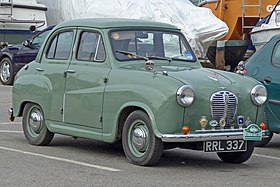 Austin A30 4-door saloon Austin A30 4-door saloon | |
| Overview | |
| Manufacturer | Austin (BMC) |
| Also called | Austin Seven |
| Production | 1951–1956 |
| Assembly | Longbridge, United Kingdom Melbourne, Australia |
| Body and chassis | |
| Class | Compact car / Small family car (C) |
| Body style | 4-door saloon 2-door saloon 2-door estate 2-door van |
| Powertrain | |
| Engine | 803 cc A-Series I4 |
| Transmission | 4-speed manual |
| Dimensions | |
| Wheelbase | 79.5 in (2,019 mm) |
| Length | 136.5 in (3,467 mm) |
| Width | 55 in (1,397 mm) |
| Chronology | |
| Predecessor | Austin 8 |
| Successor | Austin A35 Austin Mini |
The Austin A30 is a small family car produced by Austin from May 1952 to September 1956. It was launched at the 1951 Earls Court Motor Show as the "New Austin Seven" and was Austin's competitor with the Morris Minor.
At launch, the car cost £507 (equivalent to £15,793.36 in 2019) undercutting the Minor by £62.
Styling
Holden "Bob" Koto, from the Raymond Loewy design studios, created the first clay models for the A30. Austin then had its Head of Styling, Dick Burzi, revise the design, partly to reduce cost.
Features
The body structure was designed by T.K. Garrett, who had been an aeronautical engineer before joining Austin. It was of fully stressed monocoque chassis-less construction, which made it lighter and stiffer than most contemporary vehicles, the first Austin to be made in this way. Inside there were individual seats at the front and a bench at the rear covered in PVC with an option of leather facings on the seats. Evidence of economy was seen in the original AS3 version only having a single windscreen wiper, central combined stop/tail/numberplate lamp and a sun visor in front of the driver only. A passenger-side wiper and sun visor, and a heater were available as optional extras. The AS3 was also different to later models with a round speedometer and side mounted fuel filler neck. A smaller grille was fitted and an Austin winged badge mounted just above.
Originally only offered as a 4-door saloon, 2-door variants were introduced in late 1953, and in 1954 a van and van-based "Countryman" estate were made available. These later A30 had the trapezoidal speedo and dual brake/side lights. The fuel filler neck also moved to the rear panel as in the later A35 models. Despite having a smaller loading capacity than the equivalent BMC O-type Minor based vans (60 cu ft / 1.70 m as opposed to 76 cu ft / 2.15 m) the Austin van offered the same payload. Being slightly lighter and stiffer, it was favoured by businessmen, and saw long service for many. One prototype Sports Tourer was built but the vehicle was never put into production. That prototype is on display at the British Motor Museum at Gaydon in the UK.
The A30 was replaced by the Austin A35 in 1956, by which time 223,264 A30s had been built.
The A30 has a smaller rear window than the A35, and trafficators instead of modern indicators, which swung out from the B pillar when operated by a knob mounted on the centre of the dashboard.
The car, along with the larger-engined (and hence faster) A35, was quite successful in 1950s saloon car racing, and some still appear in historic events.
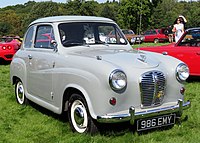 |
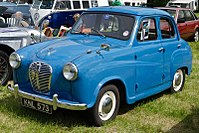 |
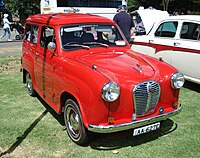 |
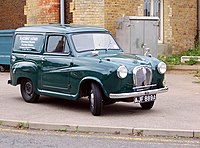 |
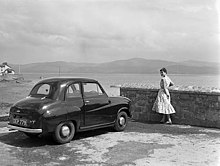 |
 |
Performance
The car's newly designed A-Series straight-4 engine was state of the art for the time and returned an average fuel consumption of 42 mpg / under 7L/100 km. With spirited driving the A30 was able to attain a top speed of 70 mph (110 km/h) (factory quoted). In its road test The Motor magazine achieved a top speed of 67.2 mph (108.1 km/h) and a 0–60 mph time of 42.3 seconds. Braking was effected by a hybrid system, with Lockheed fully hydraulic drum brakes at the front and a body-mounted single cylinder operating rods to the rear wheels, which despite being heavily criticised as archaic and old-fashioned, were reported to be quite acceptable. The rod system provided good handbrake efficiency and was applied by a lever in an unorthodox position to the right of the driver's seat (Right hand drive vehicles). Bumps were handled by independent coil springs at the front end and beam axle/semi-elliptic leaf springs at the back.
A car tested by The Motor magazine in 1952 had a top speed of 62 mph (100 km/h) and could accelerate from 0–50 mph (80 km/h) in 29 seconds. A fuel consumption of 38.8 miles per imperial gallon (7.28 L/100 km; 32.3 mpg‑US) was recorded. The test car cost £553 including taxes. The optional radio was an extra £43 and the heater £9. Performance data need to be seen in the context of fuel availability. Early in the Second World War "branded fuel" disappeared from sale in the UK, and the nationally available fuel available at the beginning of 1952 had an octane rating of just 70, which enforced relatively low compression ratios: this reduced the performance available from all cars, especially small ones. In 1952 branded fuels returned to the forecourts, available octane ratings began to increase, and compression ratios were progressively improved along with the performance figures of cars such as the Austin A30 and its A35 successor.
Australian production
The A30 was produced in Australia by the Austin Motor Company (Australia) Pty Ltd from 1952 to 1954 and by its successor, the British Motor Corporation (Australia) Pty Ltd from 1954 to 1956.
Engine
- 803 cc BMC A-Series engine inline 4.
- 58 mm bore x 76 mm stroke
- pushrod-operated overhead valves
- compression ratio 7.2:1
- single Zenith 26JS or 26VME carburettor
- 28 bhp (21 kW) at 4400 rpm
- 40 lbf·ft (54 Nm) at 2200 rpm
New Austin Seven and Austin A30 Seven
Early sales literature used the names New Austin Seven and Austin A30 Seven.
References
- AUSTIN SEVEN Car Sales Brochure c1953 #850, www.ebay.ie, as archived at web.archive.org
- Barry Anderson, Building Cars in Australia, 2012, page 198
- ^ Culshaw, David; Horrobin, Peter (1974). Complete Catalogue of British Cars. Macmillan. ISBN 0-333-16689-2.
- Robson, Graham (2006). A–Z British Cars 1945–1980. Herridge & Sons. ISBN 0-9541063-9-3.
- ^ Adams, Keith. "Austin A30/A35". aronline.co.uk. Retrieved 19 April 2016.
- Elias, Mark (20 February 2012). "A Mighty Fun Sprite". Autoweek. 62 (4): 21. ISSN 0192-9674.
- "Austin A30-35 at Austin Memories". Archived from the original on 4 May 2012. Retrieved 19 April 2012.
- Sedgwick, Michael; Gillies, Mark (1993). A–Z of cars 1945–1970. Bay View Books. ISBN 1-870979-39-7.
- "The A30 Austin Seven Road Test". The Motor. 12 November 1952.
- Daniels, Jeffery (28 May 1977). "`". Autocar. Vol. 146 (nbr 4203). pp. 58–61.
- The Macquarie Dictionary of Motoring, 1986, page 24 & 62
- Austin Seven Brochure mx9293, www.ebay.co.uk, as archived at web.archive.org
- Austin A30 Seven 1951–56, storm.oldcarmanualproject.com Retrieved 27 June 2016
Further reading
- Post War Baby Austins (1988) Sharratt, Barney ISBN 978-0-85045-710-0
- Austin A30 & A35 Super Profile (1985), Henson, Kim, Haynes Publishing Group ISBN 0-85429-469-4
- Austin A30 & A35 1951 - 1962, Brooklands Books, ISBN 0-907073-70-0
- Allen, Michael (1985). British Family Cars of the Fifties. Haynes Publishing Group. ISBN 0-85429-471-6.
External links
- Austin A30/A35 Owners' Club
- The Austin A30 Site. A30 photographs, free screensaver, parts noticeboard+
- Austin Memories—History of Austin and Longbridge
- Photo of A30 in New Zealand, 1964
| British Motor Corporation cars, 1952–1966 | |
|---|---|
| Austin | |
| Austin-Healey | |
| MG | |
| Morris | |
| Princess | |
| Riley | |
| Vanden Plas | |
| Wolseley | |